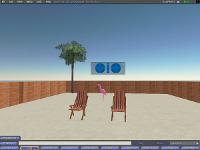Second Life - How to
- Stereo views imitate how our eyes work in the real world. Each eye should receive a different image, offset slightly horizontally. In real life, you can move a camera between shots, or use a frame with two cameras mounted on it, since it is not easy to get exactly the same angle for both shots. In Second Life™, it is easier. Just bring up the Camera Controls in the view menu.
- Position your camera to take the picture for your right eye. Choose "Snapshot to disk" from the File menu. Then, being careful not to move your avatar, click on the left arrow in the Camera Control window. It is the left pointing arrow in the right circle. Your camera position shifts left a bit.
- Do another "Snapshot to disk". OK. Now you can move. In fact, you can get out of Second Life.™ Bring up the two images in your favorite image editing program. Create a page twice as wide as an image. My snapshots are 1024 pixels wide, so I make a space 2048 pixels wide. Put the first image on the right, and the second image on the left. Then resize the image. With the stereo viewer I am using, 700 pixels wide in total works very well.
-
In these examples, I left the user interface visible in the images. Seen with a stereo viewer, the camera control window, which "floats" in front of everything in Second Life,™ appears to be all the way in the back. That is because it did not move between pictures. The more something shifts between images, the more forward your brain tells you it is when you look at the images through the stereo viewer.
- Try to avoid angles that cause some objects to be dramatically different in the two views. In the third image, the flamingo is hidden in the right eye view, and the base of the palm tree is hidden in the left eye view. The result is a very unsatisfying image in which objects kind of shimmer in and out of perception. The brain does not so easily accept the input as a 3D image when this happens. The image becomes hard to focus on.
- It may be best to shoot three or four side by side images, then play around a little picking which pair gives the best result. Sometimes a widely separated pair gives a stronger 3D effect. Sometimes too much change between images makes a picture hard to view and a closer pair works better.



